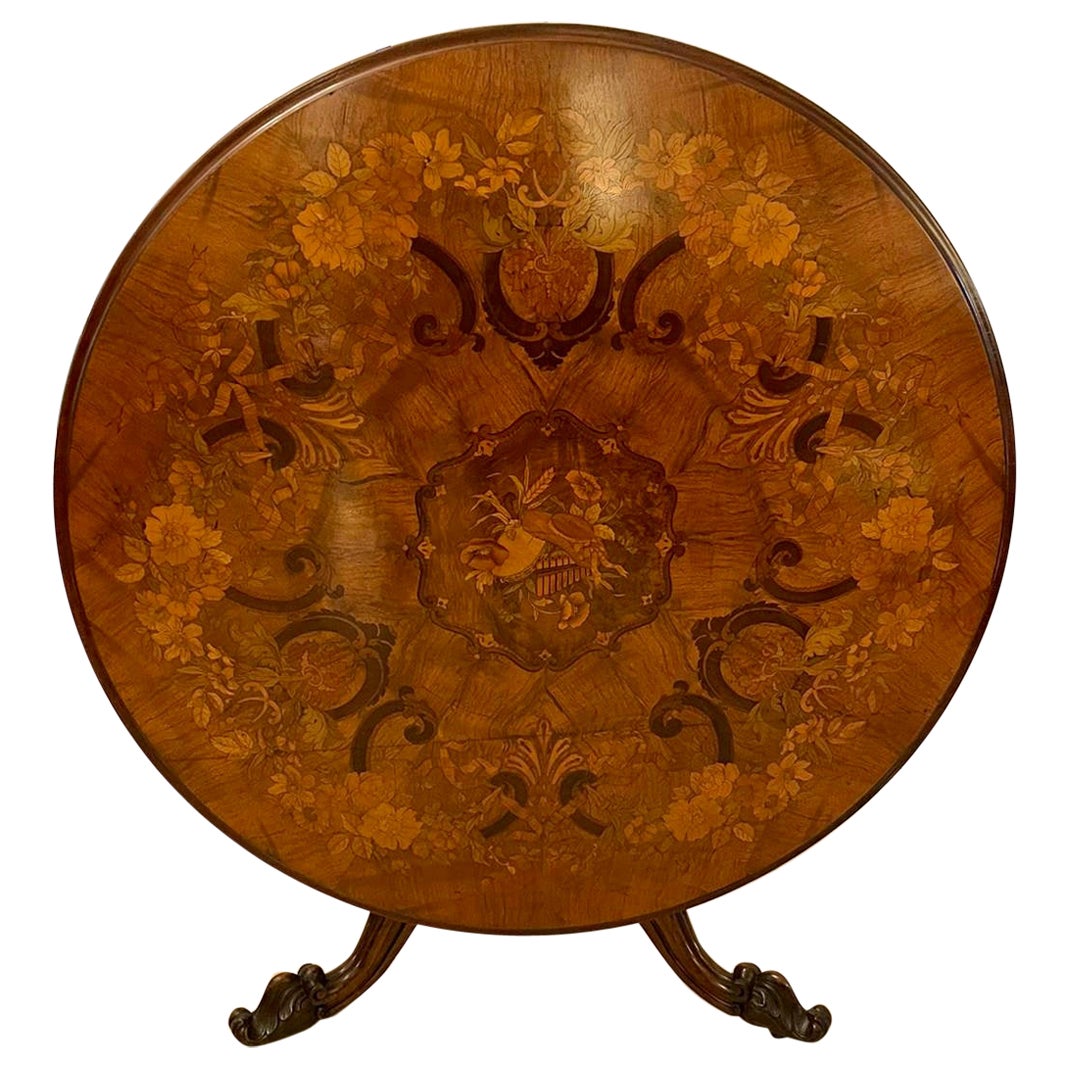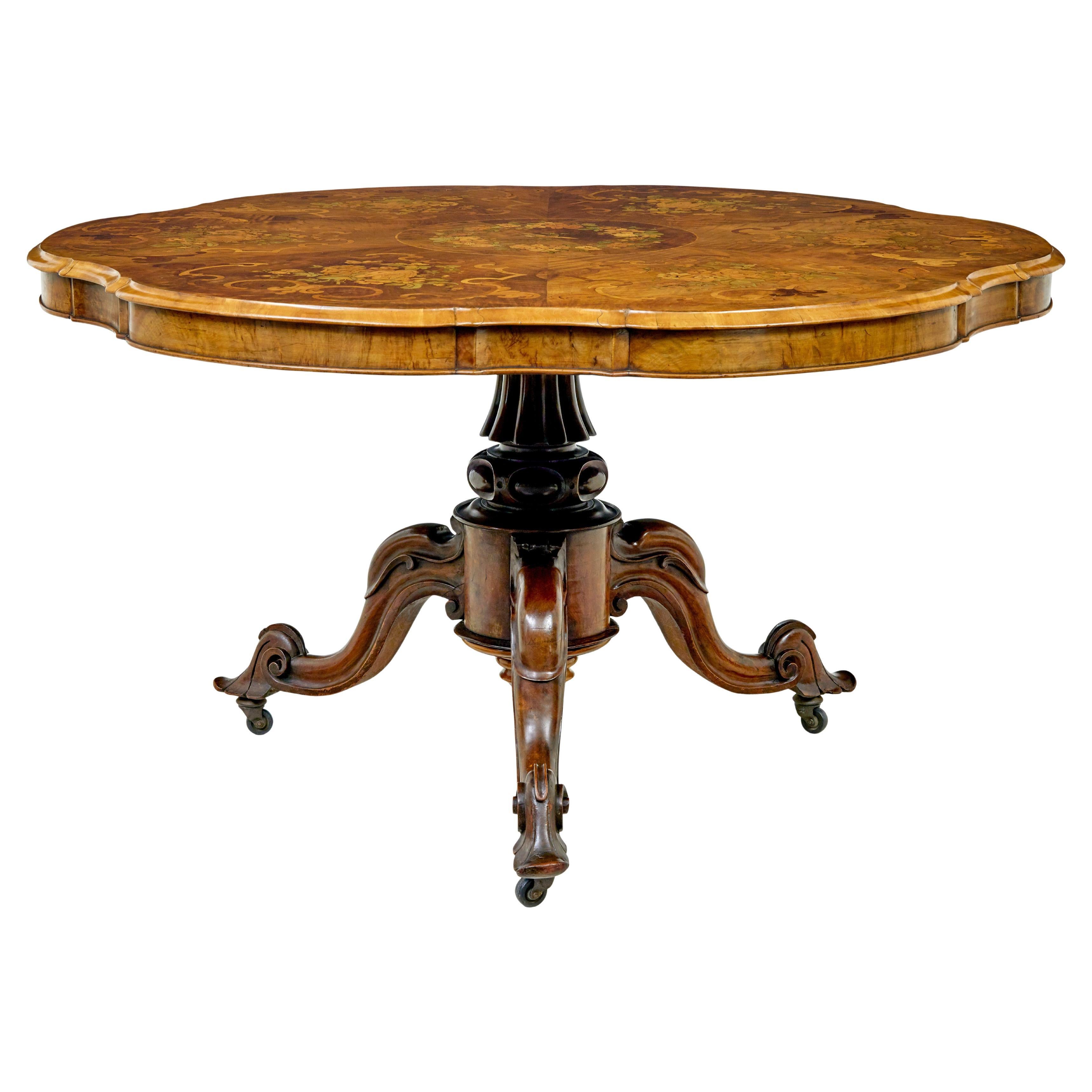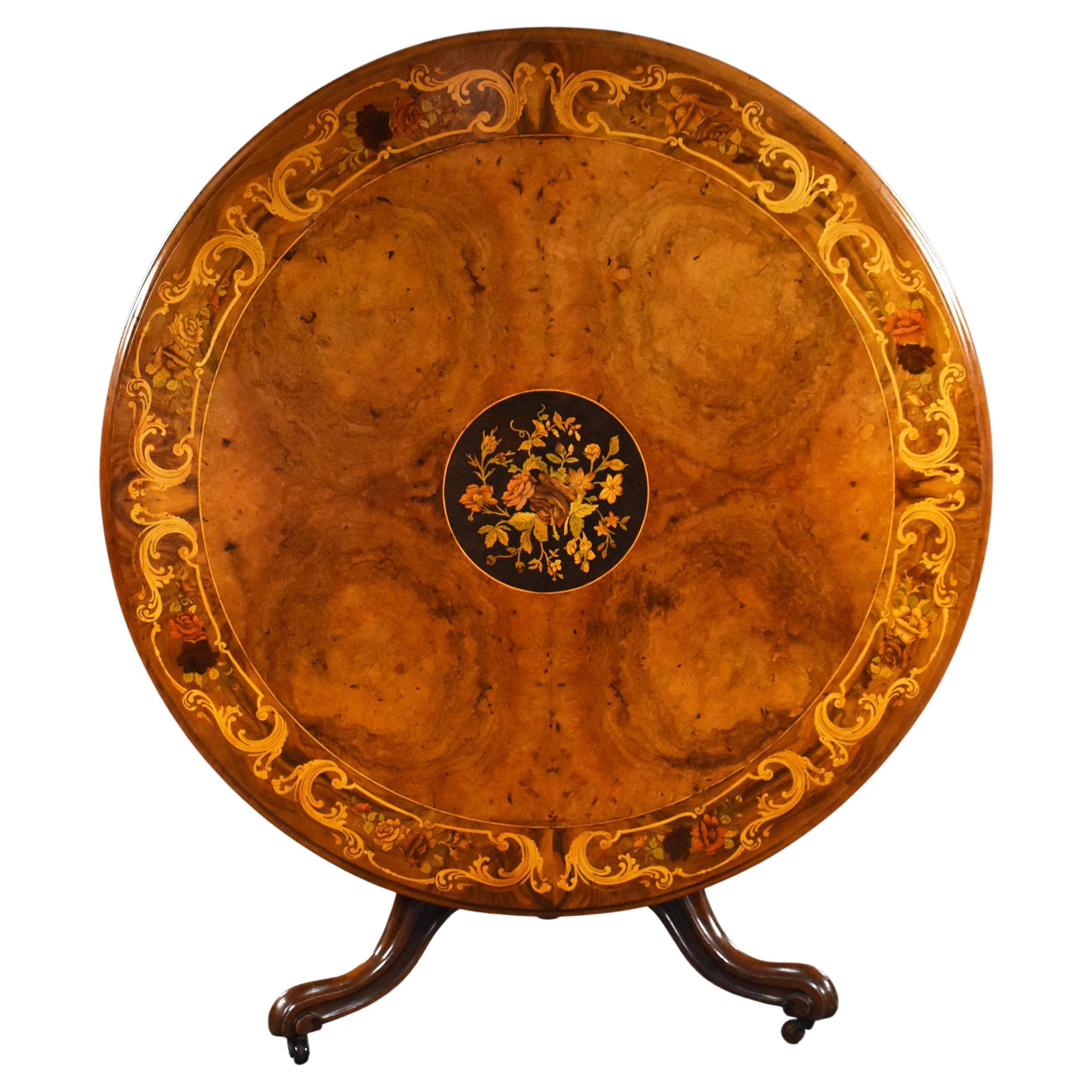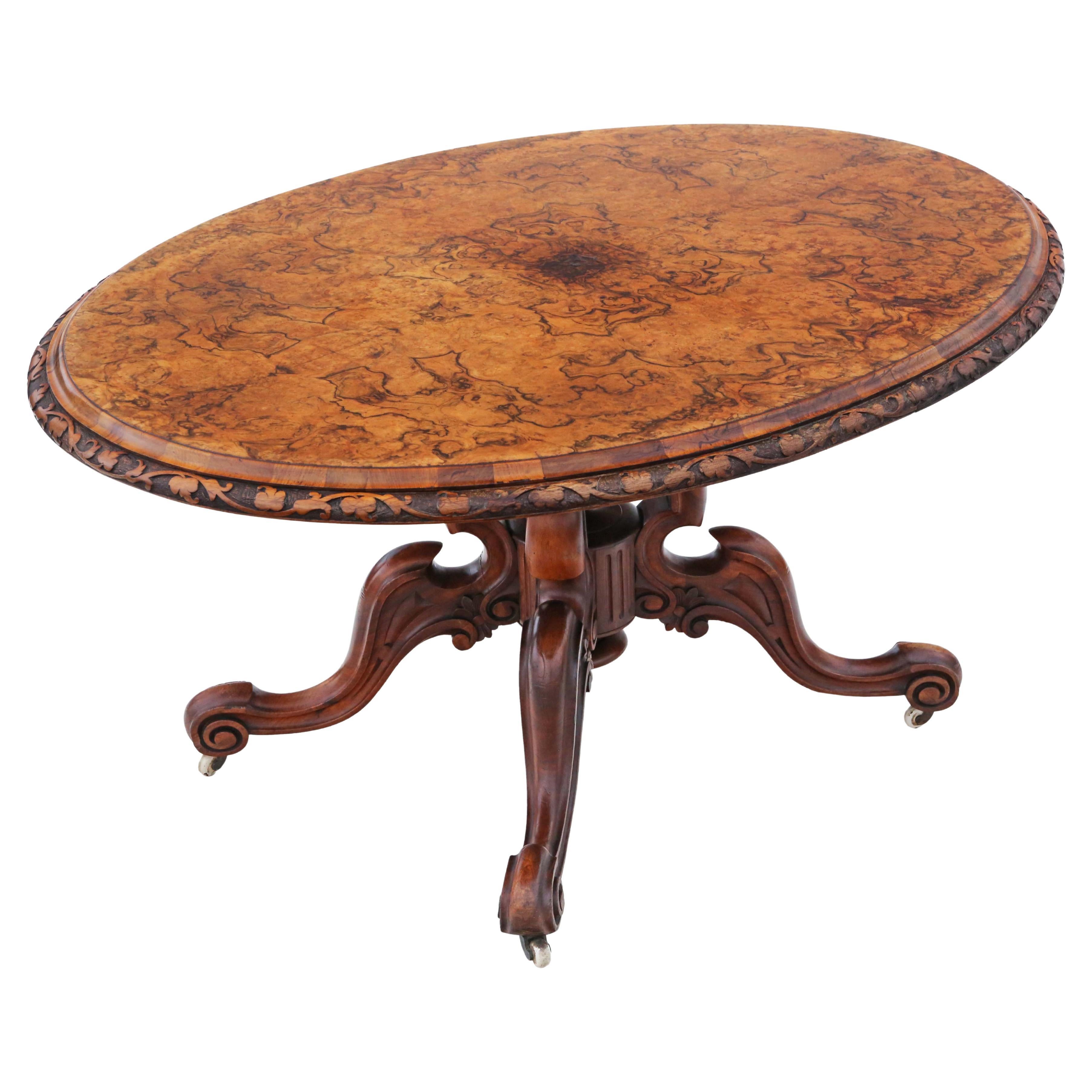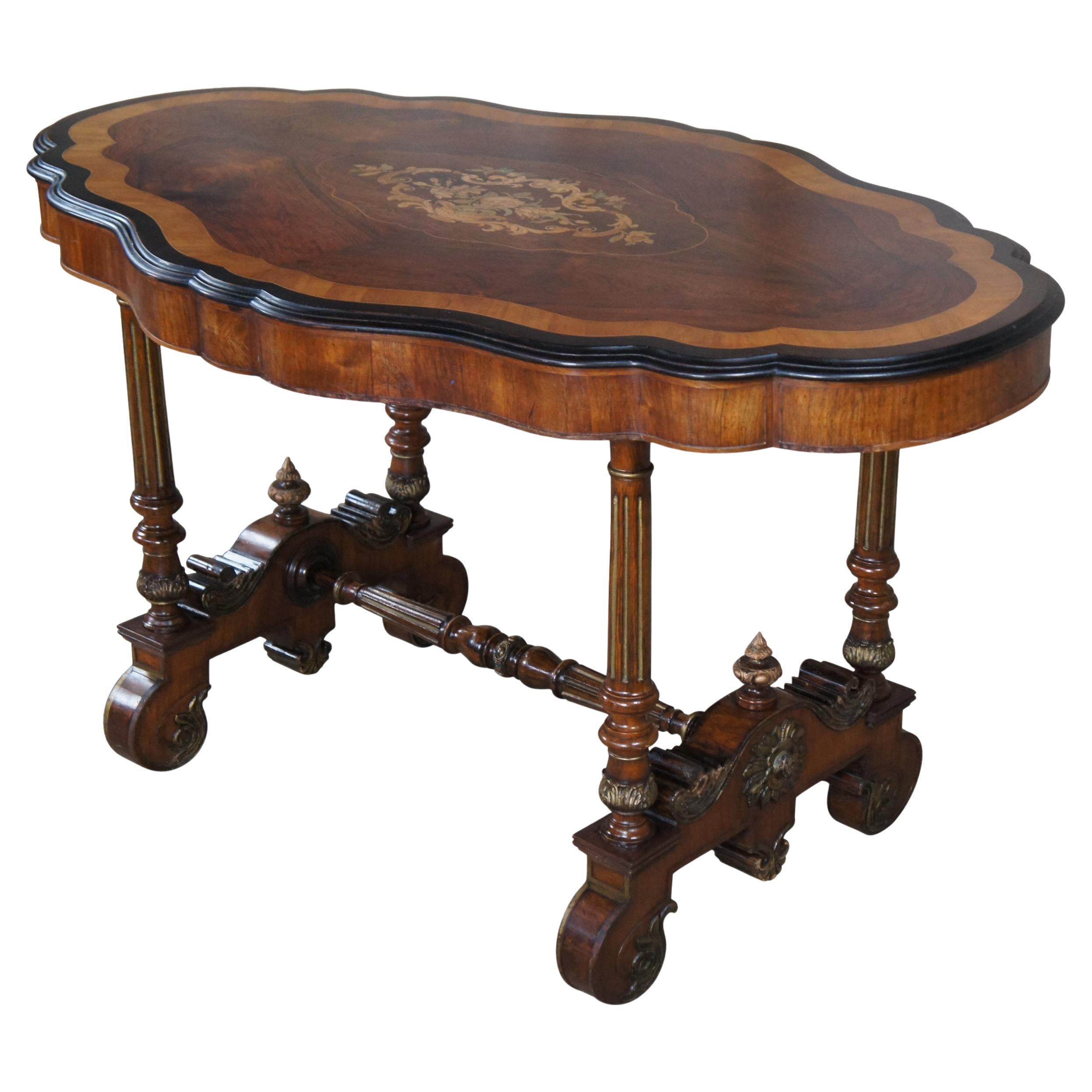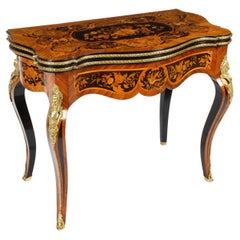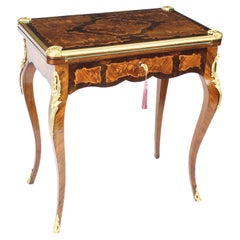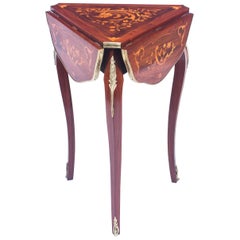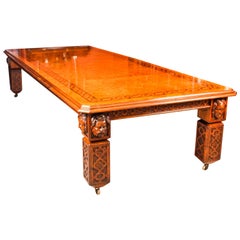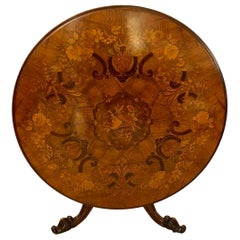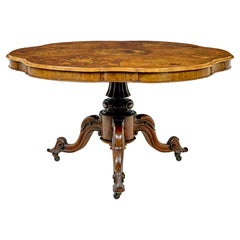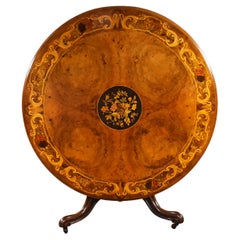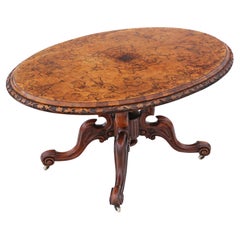Items Similar to Antique 4ft 6" diam Burr Walnut Marquetry Dining / Center Table 1860s
Video Loading
Want more images or videos?
Request additional images or videos from the seller
1 of 15
Antique 4ft 6" diam Burr Walnut Marquetry Dining / Center Table 1860s
$13,319.79
£9,500
€11,287.52
CA$18,177.69
A$20,242.50
CHF 10,535.10
MX$249,587.54
NOK 134,172.57
SEK 126,109.21
DKK 84,218.92
Shipping
Retrieving quote...The 1stDibs Promise:
Authenticity Guarantee,
Money-Back Guarantee,
24-Hour Cancellation
About the Item
This is a fine and rare antique English mid Victorian, burr walnut, ebonised and fruitwood marquetry, centre table, in the manner of Edward Holmes Baldock and circa 1860 in date.
The shaped segmentally veneered circular top is beautifully marquetry inlaid with assorted flowers within shaped cartouches and features a beautiful scrolled foliate carved edge.
It sits on a cabochon and acanthus-wrapped baluster column with three cabochon-embedded, foliate-scrolled, rocaille-carved outswept legs, with clasped feet and recessed castors.
It is extremely versatile and can be placed in your hallway, living room, dining room, or reception.
Condition:
In excellent condition having been beautifully cleaned, polished and waxed in our workshops, please see photos for confirmation.
Dimensions in cm:
Height 74 x Width 145 x Depth 145
Dimensions in inches:
Height 2 foot, 5 inches x Width 4 foot, 9 inches x Depth 4 foot, 9 inches
In 1805 Baldock's name first appears as the freehold owner of 7 Hanway Street, London. Over the years he expanded his premises. By 1840 his property in this street comprised nos 1 and 2, both with back premises, and in addition he owned a yard and no. 3, which he let. It was in 1 and 2 Hanway Street that he carried on business up to 1843 when he retired, selling his stock and moving to a fashionable residential address, Hyde Park Place. According to one 19th-century source, the business was taken over by Frederick Litchfield's father. He was buried in St Pancras Church, Euston, where he is commemorated by a marble memorial tablet on the north wall, dedicated jointly to him and Mary Frances Westoby.
In 1805 he described himself as dealer in china and glass. By 1821 he was styled in the Post Office Directories as antique furniture and ornamental china dealer, and in 1826 he described his activities in a bill heading as ‘buying, selling, exchanging and valuing China, Cabinets, Screens, Bronzes etc.’. Though Baldock's business consisted primarily in dealing in antique porcelain and furniture — largely foreign — he repaired, remodelled and altered existing furniture. He also produced designs for new pieces and had them made.
In 1836 Baldock sold French eighteenth-century furniture to Lady Stafford (Countess of Sutherland) for Dunrobin Castle, and in 1842 Scotland’s leading country house architect, William Burns, recommended to his patron O. Tyndall Bruce of Falkland House that ‘for Cabinets and China, do not omit going to Baldock’s Hanway Street, Oxford Street… which is the first place in London’.
In 1841 the Duke of Buccleuch was sent drawings of bedroom furniture as well as working drawings of an octagonal table, a bookcase and three stalls. A design of a table in the Buccleuch papers which is annotated ‘No. 3 Amboyna wood ground with coloured flowers’ is almost certainly the preliminary sketch for a table which was later made. Robert Byng (1764-1847) and George Newport, 2nd Earl of Bradford were also customers of Baldock’s. In 1840 he supplied a two encoignures with slab tops to the latter (one illus. FHS Newsletter (February 2017, p. 5). A pair of china cabinets on stands with porcelain mounts, made c.1835-43 for the 3rd Marquis of Lansdowne were sold by auctioneers, Bamfords, in 2007
A number of well-constructed and, in some cases, finely inlaid pieces of furniture are known which are 19th-century in date and which are branded with Baldock's initials, ‘EHB’. While some are pastiches of 18th-century French furniture others are in a contemporary English style. Whether these pieces were both designed by Baldock and made on his premises is impossible to tell. The ‘EHB’ mark cannot be regarded as a maker's stamp in the accepted sense of the term as it is also struck on genuine French 18th-century furniture which merely passed through Baldock's hands.
Burr Walnut
refers to the swirling figure present in nearly all walnut when cut and polished, and especially in the wood taken from the base of the tree where it joins the roots. However the true burr is a rare growth on the tree where hundreds of tiny branches have started to grow. Burr walnut produces some of the most complex and beautiful figuring you can find.
Marquetry
is decorative artistry where pieces of material of different colours are inserted into surface wood veneer to form intricate patterns such as scrolls or flowers.
The technique of veneered marquetry had its inspiration in 16th century Florence. Marquetry elaborated upon Florentine techniques of inlaying solid marble slabs with designs formed of fitted marbles, jaspers and semi-precious stones. This work, called opere di commessi, has medieval parallels in Central Italian "Cosmati"-work of inlaid marble floors, altars and columns. The technique is known in English as pietra dura, for the "hardstones" used: onyx, jasper, cornelian, lapis lazuli and colored marbles. In Florence, the Chapel of the Medici at San Lorenzo is completely covered in a colored marble facing using this demanding jig-sawn technique.
Techniques of wood marquetry were developed in Antwerp and other Flemish centers of luxury cabinet-making during the early 16th century. The craft was imported full-blown to France after the mid-seventeenth century, to create furniture of unprecedented luxury being made at the royal manufactory of the Gobelins, charged with providing furnishings to decorate Versailles and the other royal residences of Louis XIV. Early masters of French marquetry were the Fleming Pierre Golle and his son-in-law, André-Charles Boulle, who founded a dynasty of royal and Parisian cabinet-makers (ébénistes) and gave his name to a technique of marquetry employing brass with pewter in arabesque or intricately foliate designs.
Our reference: A3560
About the Seller
5.0
Platinum Seller
Premium sellers with a 4.7+ rating and 24-hour response times
Established in 1983
1stDibs seller since 2012
1,366 sales on 1stDibs
Typical response time: <1 hour
Associations
LAPADA - The Association of Arts & Antiques Dealers
- ShippingRetrieving quote...Shipping from: London, United Kingdom
- Return Policy
Authenticity Guarantee
In the unlikely event there’s an issue with an item’s authenticity, contact us within 1 year for a full refund. DetailsMoney-Back Guarantee
If your item is not as described, is damaged in transit, or does not arrive, contact us within 7 days for a full refund. Details24-Hour Cancellation
You have a 24-hour grace period in which to reconsider your purchase, with no questions asked.Vetted Professional Sellers
Our world-class sellers must adhere to strict standards for service and quality, maintaining the integrity of our listings.Price-Match Guarantee
If you find that a seller listed the same item for a lower price elsewhere, we’ll match it.Trusted Global Delivery
Our best-in-class carrier network provides specialized shipping options worldwide, including custom delivery.More From This Seller
View AllAntique French Louis Revival Floral Marquetry Card Table 19th Century
Located in London, GB
This is a stunning 19th century antique French Louis XV Revival ormolu and floral marquetry shaped rectangular card table, circa 1870 in date.
The shaped top has banded marquetry inlay encompassing an exquisite floral marquetry bouquet of country flowers with musical instruments and a stunning gilt bronze border. The shaped frieze is profusely inlaid throughout with sprays of flowers, leafy stems and musical trophies.
It has decorative ormolu cast masque bosses to the sides and is raised on serpentine legs terminating in leafy ormolu sabots.
The hinged top opens to reveal a green baize lined interior for playing cards framed...
Category
Antique 1870s Game Tables
Materials
Wood
Antique French Burr Walnut Marquetry Card/Writing/Dressing Table 19th Century
Located in London, GB
This is a rare late 19th century antique French ormolu mounted metamorphic burr walnut and floral marquetry card table, writing table and dressing table.
The shaped burr walnut to...
Category
Antique 1890s Tables
Materials
Walnut
19th Century Louis Revival Marquetry Triform Occasional Table
Located in London, GB
This is a beautiful antique Louis Revival ormolu mounted mahogany and marquetry triform occasional table, circa 1870 in date.
It has a shaped top an...
Category
Antique 1870s Tables
Materials
Ormolu
Antique Elizabethan Revival Pollard Oak Extending Dining Table, 19th Century
Located in London, GB
There is no mistaking the style and sophisticated design of this exquisite rare antique English 12ft Elizabethan Revival pollard oak extending dining table, circa 1850 in date.
The ...
Category
Antique 1850s English Elizabethan Dining Room Tables
Materials
Oak
Antique French Burr Walnut Parquetry Card Backgammon Table 19th Century
Located in London, GB
A truly fabulous antique French parquetry turnover top games table, circa 1880 in date.
The top with ormolu banded edge, the parquetry decoration exhibits a stunning array of exotic...
Category
Antique 1880s French Game Tables
Materials
Ormolu
Vintage Gillows Style Burr Walnut Writing Table Desk 20th Century
Located in London, GB
This is a sublime Vintage burr walnut writing table in the manner of Gillows dating from the second half of the 20th Century.
This elegant desk will make a wonderful addition to one...
Category
Mid-20th Century End Tables
Materials
Walnut
You May Also Like
Outstanding Quality Antique Victorian Burr Walnut Marquetry Inlaid Dining Table
Located in Suffolk, GB
Outstanding quality antique Victorian burr walnut marquetry inlaid centre/dining table having an incredible quality circular burr walnut floral marquetry inlaid top with a thumb moul...
Category
Antique 19th Century English Victorian Dining Room Tables
Materials
Walnut
19th century carved walnut marquetry center table
Located in Debenham, Suffolk
19th century carved walnut center table with inlay circa 1870.
We are pleased to offer this stunning center table of generous proportions.
Circular top with scalloped moulded edge....
Category
Antique Late 19th Century English High Victorian Center Tables
Materials
Walnut
19th Century Victorian Burr Walnut & Marquetry Circular Breakfast
Located in Chelmsford, Essex
For sale is a good quality Victorian burr walnut & marquetry circular breakfast table, having a well figured and inlaid top, above a...
Category
Antique Mid-19th Century English Victorian Dining Room Tables
Materials
Kingwood, Satinwood, Walnut
Antique Fine Quality Large 19th Century Victorian Burr Walnut Breakfast Table
Located in Wisbech, Cambridgeshire
Antique fine quality large Victorian 19th century burr walnut marquetry oval tilt top loo breakfast table.
This is a lovely table (far better than most), that is full of age, charm ...
Category
Antique 19th Century Dining Room Tables
Materials
Walnut
$2,939 Sale Price
30% Off
Antique American Renaissance Revival Serpentine Walnut Marquetry Center Table
Located in Dayton, OH
An exceptional American Renaissance Revival center table, circa late 19th century. Features a serpentine form with walnut burl top centered by floral marquetry, inlay and banding. Th...
Category
Antique Late 19th Century Renaissance Revival Center Tables
Materials
Walnut
$2,320 Sale Price
20% Off
Magnificent Quality 8/10 Seater Antique Burr Walnut Carved Gilded Dining Table
Located in Suffolk, GB
Magnificent quality 8 seater antique burr walnut marquetry inlaid carved gilded centre/dining table
having a large exceptional quality burr walnut inlaid marquetry circular top, sup...
Category
Early 20th Century English Dining Room Tables
Materials
Walnut
